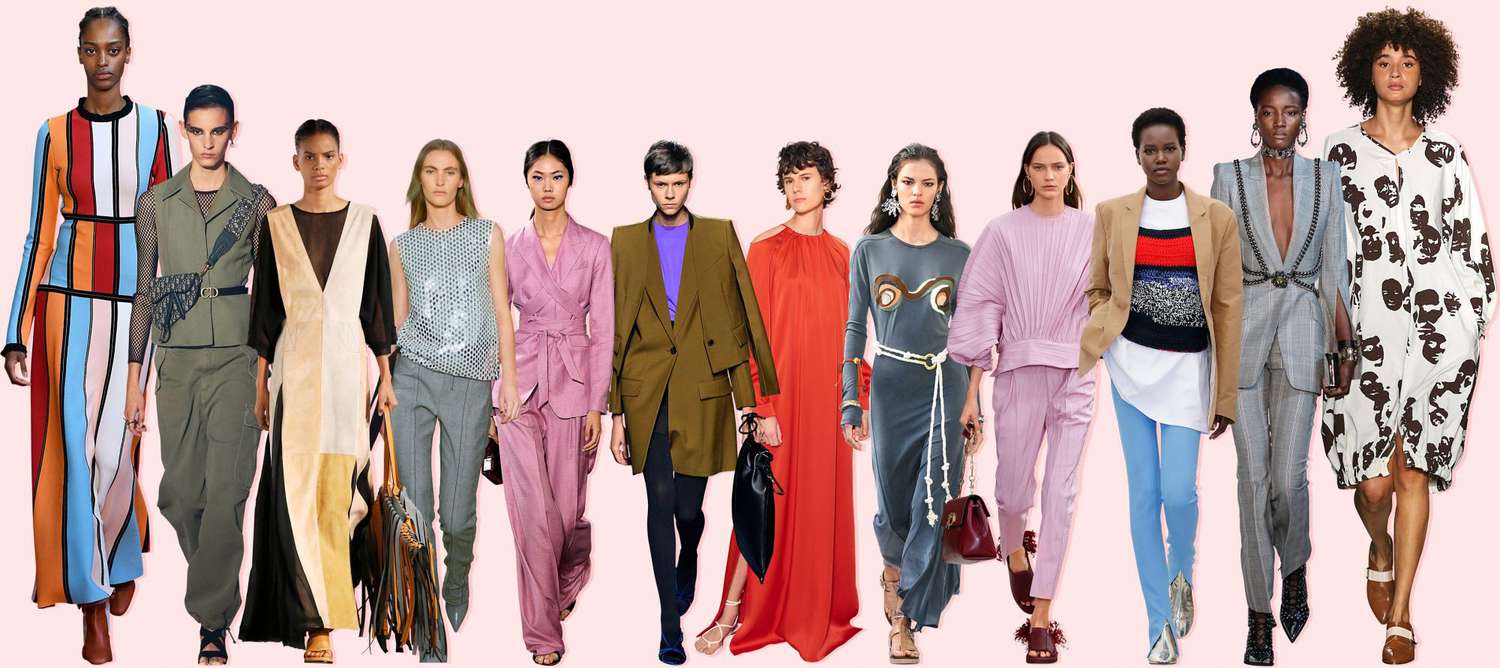A Guide to Choosing Weather-Appropriate Branded Clothing Materials
A Guide to Choosing Weather-Appropriate Branded Clothing Materials
Blog Article
Comprehending Clothes: The Relevance of Textile Options in Your Closet
The choice of textile in clothing plays an essential role in both aesthetic appeals and capability. Different materials provide varying levels of convenience, toughness, and breathability, straight influencing the user's experience. Understanding these nuances can boost one's closet considerably. Yet, many neglect how these selections can impact not simply individual design, yet also sustainability. What material decisions could redefine your closet and straighten it with both style and responsibility?
The Function of Fabric in vogue and Capability

Common Fabric Types and Their Features
When selecting garments, comprehending the characteristics of typical textile kinds is necessary for making informed choices. Cotton, a widely-used all-natural fiber, is understood for its flexibility, breathability, and softness, making it suitable for casual wear and day-to-day garments. Linen, an additional natural option, boasts excellent moisture-wicking residential properties and an unique texture, suitable for warm climates.Wool, usually preferred for its warmth and toughness, varies in excellence; merino woollen is soft versus the skin, while coarser types are used for outerwear. Synthetic textiles like polyester and nylon use toughness and resistance to creases, making them popular for activewear and travel garments. Finally, blends, which integrate natural and artificial fibers, can enhance capability while preserving comfort. By recognizing these material qualities, individuals can pick clothes that aligns with their way of living and visual preferences.
Breathability and Comfort: Picking the Right Fabrics for Different Environments
Selecting the right textiles for numerous climates can substantially improve comfort and total wearability. Breathable products are necessary in hot climates, as they enable air flow and dampness dissipation. Fabrics such as cotton, bed linen, and moisture-wicking synthetics effectively attract sweat far from the body, keeping the user cool and completely dry. Alternatively, in cooler environments, thicker textiles like woollen or fleece offer insulation while preserving breathability, making sure heat without overheating.Additionally, the option of fabric weight plays an important function; lightweight textiles are more effective for summertime, whereas much heavier options are fit for winter wear. Understanding the distinct residential properties of each fabric makes it possible for people to clothe suitably for differing weather. Ultimately, picking comfy and breathable fabrics customized to particular environments can greatly improve daily comfort and improve the general experience of wearing apparel.
Toughness and Care: How Textile Affects Long Life of Your Closet
Picking the right products can significantly impact the resilience and treatment needs of a wardrobe. Fabrics such as cotton and polyester are understood for their resilience and simplicity of upkeep, making them perfect for day-to-day wear. On the other hand, fragile materials like silk and shoelace call for more cautious handling and specialized cleaning methods, which can increase the time and initiative required for care. Branded Clothing.Durability is additionally influenced by the material's weave and coating; securely woven textiles tend to resist wear and tear much better than loosely woven alternatives. Additionally, synthetic blends typically give enhanced longevity, integrating the very best high qualities of multiple fibers.Understanding the care guidelines for each and every fabric is necessary, as improper washing or drying can bring about premature wear. Inevitably, selecting long lasting materials can cause a longer-lasting wardrobe, lowering the regularity of replacements and adding to a more sustainable fashion option
The Effect of Fabric on Fit and Shape

Lasting Material Choices: Making Eco-Friendly Decisions
The influence of fabric expands past fit and shape to encompass environmental factors, triggering an expanding rate of interest in sustainable material selections. Green textiles, such as organic cotton, hemp, and Tencel, are acquiring grip among customers that focus on sustainability in their wardrobes. These products are frequently produced with less chemicals and water, lowering their environmental footprint.Additionally, recycled textiles, made from post-consumer waste, supply an ingenious remedy to the textile market's air pollution trouble. Brands progressively embrace transparency in their sourcing approaches, allowing consumers to make informed decisions concerning their purchases.Choosing lasting textiles not only supports honest techniques yet additionally motivates the style market to take on more accountable manufacturing methods. As recognition of environmental problems increases, individuals are advised to review the lasting impact of their fabric selections, promoting a motion in the direction of a much more sustainable and eco conscious approach to style.
Elevating Style: How Textile Can Transform an Attire
While numerous might focus on shade and cut when selecting an outfit, the selection of material plays an important function in raising design and improving overall appearance. Various materials share distinctive moods and messages; as an example, silk exhibits luxury and class, while denim supplies More Info a laid-back, loosened up ambiance. The appearance and drape of a material can substantially change the shape, with structured textiles giving a sleek look and softer ones creating a more fluid, loosened up aesthetic.Moreover, the weight of the textile affects wearability across seasons. Lightweight fabrics like linen and cotton are suitable for summertime, while larger materials such as woollen and velvet give warmth and beauty in chillier months. Recognizing fabric homes, such as breathability and stretch, additionally empowers individuals to make enlightened choices that enhance comfort without compromising style. Inevitably, the appropriate material can change a clothing from normal to extraordinary, making it an important consideration in any kind of wardrobe.
Often Asked Questions
How Do I Determine the Textile Web Content of My Apparel?
To recognize textile web content, one can take a look at care tags, conduct melt tests for fiber recognition, or speak with fabric swatches. These methods help separate materials, guaranteeing educated selections for apparel care and maintenance in everyday wear.
Can Fabric Selection Affect My Mood or Self-confidence?
Textile selection can considerably influence an individual's mood and confidence. Branded Clothing. Certain products might evoke sensations of comfort or elegance, while others you can find out more can feel uncomplimentary or limiting, inevitably influencing self-perception and psychological wellness throughout the day
What Fabrics Are Finest for Delicate Skin?
For people with sensitive skin, all-natural fabrics like bamboo, cotton, and linen are usually advised. These materials are breathable, hypoallergenic, and much less likely to create irritation, making them suitable selections for convenience and skin health.
Exactly how Do I Properly Laundry and Look After Different Fabrics?
To properly wash and care for various textiles, one have to consider each material's details needs, including temperature level setups, detergents, and drying out methods, guaranteeing long life and keeping the material's original qualities for ideal use.
Exist Specific Fabrics for Athletic or Efficiency Wear?
Sports or efficiency wear commonly utilizes fabrics such as nylon, polyester, and spandex. These materials are made for moisture-wicking, breathability, and flexibility, boosting activity and comfort during exercises while supplying sturdiness and support. On the other hand, in chillier climates, thicker textiles like wool or fleece give insulation while preserving breathability, making sure heat without overheating.Additionally, the selection of textile weight plays an important role; light-weight textiles are more suitable for summer season, whereas much heavier alternatives are fit for wintertime wear. In comparison, fragile products like silk and lace need more mindful handling and specialized cleaning techniques, which can increase the time and initiative his response needed for care.Durability is likewise influenced by the fabric's weave and finish; tightly woven materials have a tendency to resist wear and tear better than freely woven options. In comparison, stiff materials can limit movement however provide a traditional, polished look.Moreover, the density and appearance of the material can affect the visual understanding of body form. The impact of material prolongs past fit and shape to incorporate ecological elements, prompting an expanding rate of interest in sustainable fabric selections. The texture and drape of a material can drastically change the shape, with structured materials providing a refined appearance and softer ones creating a more fluid, unwinded aesthetic.Moreover, the weight of the fabric influences wearability across seasons.
Report this page